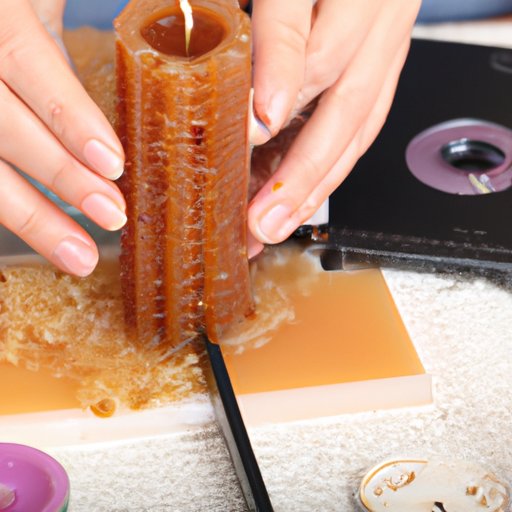
I. Introduction
Have you ever wished you could bring some cozy candlelight into your home, but never found the perfect scent or color? Look no further than making candles yourself! Not only is it a fun and easy DIY project, but it allows for endless creativity in personalizing the look, scent, and ambiance. This article will walk you through everything you need to know about making candles at home!
II. From wax to wick: Materials you need to make candles at home
The basic materials needed for candle making are wax, wicks, and a container to pour them in. Beyond these, you may also choose to add fragrances, dyes, or accessories such as dried flowers or glitter. These materials can be found at craft stores, online, or sometimes even at your local grocery store.
Wax can come in different forms, such as beeswax, soy wax, or paraffin wax. It is important to choose the right type of wax depending on what kind of candle you want to make. For example, soy wax is a wonderful choice for scented candles because it holds fragrance well, while beeswax is a great natural option that gives off a lovely, subtle honey scent. Wicks come in different sizes and materials, such as cotton or metal, and the size will depend on the diameter of your container. Don’t forget a way to melt the wax, such as a double boiler or a dedicated wax melting pot!
III. A step-by-step guide to making your own candles
First, prepare your workspace by laying down newspaper or wax paper to protect surfaces from any spilled wax. Measure out your wax and melt it down in a double boiler or melting pot, stirring occasionally. While the wax melts, prepare your containers by attaching the wicks to the bottom and centering them in your chosen vessel. Once the wax is melted, add fragrance and dye if desired, and stir until completely combined. Check the temperature with a thermometer, and pour the wax into each container slowly and steadily. Let your candles cool and set completely before trimming the wicks.
It’s important to note that moisture can affect the outcome of your candles, so it’s best to make candles on a dry, low humidity day. It’s also crucial to make sure the wax and containers reach the right temperature for optimal results.
IV. DIY candles: Experiment with different scents and colors
One of the best parts of making candles is the ability to personalize them with different scents and colors. Essential oils, fragrance oils, and even spices like cinnamon or vanilla extract can be added for wonderful scents. Dyes or natural colorants such as beet juice or turmeric can be used for beautiful colors. Some fun scent and color combinations to try might include lavender and purple dye, or citrus and yellow dye.
V. The art of candle making: Tips and tricks for beginners
For a great candle, it’s important to choose the right wax for your needs, pour at the right temperature, and use the correct wick size. Additionally, choosing the right containers can also make a big difference. A taller, narrower container will help the candle burn evenly, while a wide container may mean the wax burns faster in the middle. If you want a textured candle, you can try sprinkling in non-flammable items such as glitter or dried flowers at the end of the pouring process.
VI. Adding a personal touch: Customizing your homemade candles
Why stop at just choosing scents and colors? You can also make your candles stand out by choosing unique jars or containers. Upcycling old mason jars, teacups, or wine glasses can result in charming and one-of-a-kind candles. You can also add labels or even create a custom logo stamp to make your candles look like they came from a boutique shop.
VII. Alternative candle making techniques: Beeswax, soy wax, and other options
While paraffin wax is a popular choice for many candle makers, there are other types of wax to explore as well. Beeswax is a natural option that gives off a lovely honey scent and is perfect for making natural and wholesome-looking candles. Soy wax is also a popular choice due to its eco-friendliness and ability to hold fragrance well. There are even vegan candle waxes made from plant-based materials, if that is important to you.
VIII. Candle making safety 101: Precautions to take while making candles
While candle making is a rewarding and satisfying hobby, it’s important to take safety precautions to prevent accidents. Always wear gloves and long sleeves when working with hot wax, and use a thermometer to manage temperature. If the wax or containers get too hot, they can crack or even explode. Additionally, be sure to never leave a burning candle unattended, and keep candles away from flammable items such as curtains or paper towels.
IX. Conclusion
Now that you know everything you need to about candle making, what are you waiting for? Experiment with different scents, colors, and techniques to create your own signature candles.





